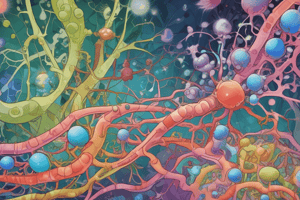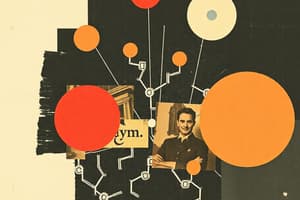Podcast
Questions and Answers
What is the primary action of glucagon on adipocytes?
What is the primary action of glucagon on adipocytes?
- Decreases cAMP level, activating fatty acyl-CoA
- Decreases cAMP level, inhibiting lipase activity
- Increases cAMP level, activating lipase (correct)
- Increases cAMP level, activating acetyl-CoA carboxylase
Which hormone is responsible for protein dephosphorylation in high blood sugar conditions?
Which hormone is responsible for protein dephosphorylation in high blood sugar conditions?
- Epinephrine
- Insulin (correct)
- Glucagon
- Cortisol
What effect does malonyl-CoA have on fatty acyl-CoA?
What effect does malonyl-CoA have on fatty acyl-CoA?
- Inhibits entry into mitochondria (correct)
- Promotes entry into mitochondria
- Activates acetyl-CoA carboxylase
- Increases breakdown of fatty acids
Where does the synthesis of new membrane lipids primarily occur?
Where does the synthesis of new membrane lipids primarily occur?
Which of the following describes glycerophospholipids?
Which of the following describes glycerophospholipids?
Which substance is NOT a source of acetyl-CoA for fatty acid synthesis?
Which substance is NOT a source of acetyl-CoA for fatty acid synthesis?
Which enzyme is specifically inhibited in bacteria to block fatty acid synthesis?
Which enzyme is specifically inhibited in bacteria to block fatty acid synthesis?
What is the fate of excess carbohydrates in the human body?
What is the fate of excess carbohydrates in the human body?
What is a characteristic of animals regarding the introduction of double bonds in fatty acids?
What is a characteristic of animals regarding the introduction of double bonds in fatty acids?
Which process does NOT involve fatty acid metabolism regulation?
Which process does NOT involve fatty acid metabolism regulation?
What is the initial step in fatty acid elongation and desaturation?
What is the initial step in fatty acid elongation and desaturation?
What is the main role of triacylglycerols in the human body?
What is the main role of triacylglycerols in the human body?
What is the role of pyruvate dehydrogenase in fatty acid synthesis?
What is the role of pyruvate dehydrogenase in fatty acid synthesis?
What is the primary product of fatty acid synthesis after seven cycles?
What is the primary product of fatty acid synthesis after seven cycles?
Which enzyme is responsible for the condensation step in fatty acid synthesis?
Which enzyme is responsible for the condensation step in fatty acid synthesis?
How many carbon atoms are added to the fatty acyl chain during each cycle of synthesis?
How many carbon atoms are added to the fatty acyl chain during each cycle of synthesis?
Which two residues are attachment points for acyl chains in the fatty acid synthase complex?
Which two residues are attachment points for acyl chains in the fatty acid synthase complex?
What is produced during the reduction step following dehydration in the fatty acid synthesis pathway?
What is produced during the reduction step following dehydration in the fatty acid synthesis pathway?
What is the role of palmityl thioesterase in fatty acid synthesis?
What is the role of palmityl thioesterase in fatty acid synthesis?
What is the total number of cycles required to synthesize a 16-carbon fatty acid chain?
What is the total number of cycles required to synthesize a 16-carbon fatty acid chain?
Which compound is essential for the condensation of acyl chains during the synthesis process?
Which compound is essential for the condensation of acyl chains during the synthesis process?
What is the main role of Acetyl-CoA carboxylase in fatty acid biosynthesis?
What is the main role of Acetyl-CoA carboxylase in fatty acid biosynthesis?
Which of the following statements about fatty acid biosynthesis is incorrect?
Which of the following statements about fatty acid biosynthesis is incorrect?
What are the starting materials for the overall reaction to synthesize palmitic acid?
What are the starting materials for the overall reaction to synthesize palmitic acid?
What is a key metabolite produced during the carboxylation of acetyl-CoA?
What is a key metabolite produced during the carboxylation of acetyl-CoA?
Which component is essential for the attachment of an acyl chain during the fatty acid synthesis process?
Which component is essential for the attachment of an acyl chain during the fatty acid synthesis process?
What regulates lipid metabolism during varying blood glucose levels?
What regulates lipid metabolism during varying blood glucose levels?
Which lipids are synthesized through processes discussed in the content?
Which lipids are synthesized through processes discussed in the content?
What is the role of lovastatin and atorvastatin in cholesterol biosynthesis?
What is the role of lovastatin and atorvastatin in cholesterol biosynthesis?
How many isoprene units are needed for the formation of squalene?
How many isoprene units are needed for the formation of squalene?
Which process is NOT involved in the formation of cholesterol from squalene?
Which process is NOT involved in the formation of cholesterol from squalene?
What are the potential fates of newly synthesized cholesterol?
What are the potential fates of newly synthesized cholesterol?
What substance is formed directly from the condensation of 6 isoprene units?
What substance is formed directly from the condensation of 6 isoprene units?
What is the precursor for Eicosanoids?
What is the precursor for Eicosanoids?
Which enzyme is the first in the biosynthesis of Eicosanoids?
Which enzyme is the first in the biosynthesis of Eicosanoids?
What differentiates COX-1 and COX-2?
What differentiates COX-1 and COX-2?
Which of the following statements is true about Vioxx?
Which of the following statements is true about Vioxx?
What are thromboxanes primarily known for?
What are thromboxanes primarily known for?
Which of the following is NOT a side effect of cyclooxygenase inhibition?
Which of the following is NOT a side effect of cyclooxygenase inhibition?
What is a characteristic of Salicylic acid?
What is a characteristic of Salicylic acid?
Which of the following is NOT a function of Prostaglandins?
Which of the following is NOT a function of Prostaglandins?
Flashcards
Fatty Acid Biosynthesis
Fatty Acid Biosynthesis
The process by which fatty acids are created from simpler molecules in the cytosol.
Acetyl-CoA Carboxylase (ACC)
Acetyl-CoA Carboxylase (ACC)
Enzyme that converts acetyl-CoA to malonyl-CoA, a crucial step in fatty acid synthesis.
Malonyl-CoA
Malonyl-CoA
A crucial intermediate in fatty acid biosynthesis, formed from acetyl-CoA.
Fatty Acid Synthase (FAS)
Fatty Acid Synthase (FAS)
Signup and view all the flashcards
Palmitic Acid
Palmitic Acid
Signup and view all the flashcards
Acyl Carrier Protein (ACP)
Acyl Carrier Protein (ACP)
Signup and view all the flashcards
Fatty acid elongation
Fatty acid elongation
Signup and view all the flashcards
Lipid Synthesis from other molecules
Lipid Synthesis from other molecules
Signup and view all the flashcards
Fatty Acid Chain Elongation
Fatty Acid Chain Elongation
Signup and view all the flashcards
Fatty Acid Synthase (FAS) Complex
Fatty Acid Synthase (FAS) Complex
Signup and view all the flashcards
ACP(Acyl carrier protein)
ACP(Acyl carrier protein)
Signup and view all the flashcards
Palmityol thioesterase
Palmityol thioesterase
Signup and view all the flashcards
Fatty Acid Synthesis Cycle
Fatty Acid Synthesis Cycle
Signup and view all the flashcards
Number of cycles for Palmitic Acid Synthesis
Number of cycles for Palmitic Acid Synthesis
Signup and view all the flashcards
Glucagon's effect on blood sugar
Glucagon's effect on blood sugar
Signup and view all the flashcards
Insulin's effect on blood sugar
Insulin's effect on blood sugar
Signup and view all the flashcards
Malonyl-CoA's role in fatty acid metabolism
Malonyl-CoA's role in fatty acid metabolism
Signup and view all the flashcards
Glycerophospholipids Synthesis
Glycerophospholipids Synthesis
Signup and view all the flashcards
Long-term Regulation of Lipids
Long-term Regulation of Lipids
Signup and view all the flashcards
Fatty acid synthesis inhibitor
Fatty acid synthesis inhibitor
Signup and view all the flashcards
Enoyl-ACP reductase
Enoyl-ACP reductase
Signup and view all the flashcards
Acetyl-CoA transport
Acetyl-CoA transport
Signup and view all the flashcards
Fatty acid sources
Fatty acid sources
Signup and view all the flashcards
Triacylglycerols
Triacylglycerols
Signup and view all the flashcards
Essential fatty acids
Essential fatty acids
Signup and view all the flashcards
Fatty acid elongation and desaturation
Fatty acid elongation and desaturation
Signup and view all the flashcards
Triacylglycerol biosynthesis site
Triacylglycerol biosynthesis site
Signup and view all the flashcards
Sphingolipid Backbone
Sphingolipid Backbone
Signup and view all the flashcards
Sphingolipid Head Group
Sphingolipid Head Group
Signup and view all the flashcards
Gangliosides
Gangliosides
Signup and view all the flashcards
Eicosanoids
Eicosanoids
Signup and view all the flashcards
Prostaglandins
Prostaglandins
Signup and view all the flashcards
Thromboxanes
Thromboxanes
Signup and view all the flashcards
COX Enzyme
COX Enzyme
Signup and view all the flashcards
COX-1 vs. COX-2
COX-1 vs. COX-2
Signup and view all the flashcards
What is lovastatin?
What is lovastatin?
Signup and view all the flashcards
What are isoprene units?
What are isoprene units?
Signup and view all the flashcards
How is squalene formed?
How is squalene formed?
Signup and view all the flashcards
Cholesterol from squalene
Cholesterol from squalene
Signup and view all the flashcards
Fates of cholesterol
Fates of cholesterol
Signup and view all the flashcards
Study Notes
Lipid Biosynthesis Learning Objectives
- Lipid biosynthesis is vital for various functions
- Fatty acid biosynthesis involves acetyl-CoA carboxylase and fatty acid synthase, encompassing chemical changes and utilizing ATP
- Fatty acid elongation and desaturation processes are briefly explained
- Conversion of carbohydrates and amino acids to fatty acids is described
- Regulation of lipid metabolism correlates with blood glucose levels
- Triacylglycerols, phospholipids, eicosanoids, and cholesterol biosynthesis are part of the overall process
Subcellular Lipid Metabolism Locations
- Animal cells/yeast cells: Mitochondria are crucial for fatty acid oxidation, acetyl-CoA production, ketone body synthesis, and fatty acid elongation. The endoplasmic reticulum handles phospholipid and sterol synthesis (later stages), as well as fatty acid elongation and desaturation. The cytosol is where NADPH production (via pentose phosphate pathway and malic enzyme) occurs, along with earlier stages of isoprenoid/sterol synthesis and fatty acid synthesis. Malate is converted to pyruvate through a malic enzyme-catalyzed reaction, and NADP is converted to NADPH.
- Plant cells: Chloroplasts are the site of NADPH and ATP production, and fatty acid synthesis. Glyoxysomes are involved in fatty acid oxidation.
Fatty Acid Biosynthesis
- Fatty acids are synthesized in the cytosol, not a simple reversal of fatty acid oxidation
- Palmitic acid (16:0) biosynthesis involves 8 acetyl-CoA, 7 ATP, 14 NADPH and 14 H⁺ molecules. The process ends up giving palmitic acid, 7ADP, 7Pi, 14 NADP⁺, 6H₂O and 8 coenzyme-A
- Two enzymes are involved in this process: Acetyl-CoA Carboxylase and Fatty Acid Synthase
Acetyl-CoA Carboxylase (ACC)
- ACC catalyses the carboxylation of acetyl CoA to yield malonyl CoA
- This reaction is a committed step in fatty acid biosynthesis in animals
Fatty Acid Synthase (FAS) complex
- FAS is a multi-enzyme protein complex with three polypeptides
- Acyl Carrier Protein (ACP), a subunit, contains phosphopantetheine for acyl chain attachment
- Cycles of condensation, reduction, dehydration and reduction reactions occur during acyl chain lengthening
- The fatty acyl chain with 16 carbons is cleaved from ACP at the end of the reaction.
Triclosan
- Triclosan, an antibacterial chemical, inhibits fatty acid synthesis by specifically blocking enoyl-ACP reductase.
Transport of acetyl-CoA
- Acetyl-CoA is carried from the mitochondria into the cytosol for fatty acid synthesis via a tricarboxylate transport system.
- Sources include pyruvate from glucose catabolism. The pyruvate is converted into Acetyl CoA
Elongation and Desaturation of Fatty Acids
- Palmitate is the starting material for elongation and desaturation of longer-chain fatty acids, including stearate and oleate.
- Elongation increases the number of carbons
- Desaturation introduces double bonds
Essential Fatty Acids
- Animals cannot synthesize certain fatty acids like linoleate and α-linolenate; thus, they are essential dietary components
- Plants can produce a variety of polyunsaturated fatty acids from oleate. These can be further desaturated
Biosynthesis of Glycerophospholipids
- Glycerophospholipids have a glycerol backbone
- Two main pathways activate polar head groups (e.g., ethanolamine or choline) using CTP, producing CDP-ethanolamine or CDP-choline, respectively
- The phosphoryl group then attacks CTP, forming CDP-ethanolamine or CDP-choline. The PPi product is further hydrolyzed
- The activated head groups are transferred to diacylglycerol to generate the glycerophospholipids.
Biosynthesis of Sphingolipids
- Sphingolipids have a sphinganine backbone (a C18 amino alcohol)
- Palmitoyl-CoA and serine are the starting materials
- Several reactions (including 3-ketosphinganine synthase, 3-ketodihydrosphingosine reductase) lead to sphinganine
- N-acylsphinganine (dihydroceramide) is then formed from sphinganine through acyl-CoA transferase
- Further reactions produces ceramide, a precursor to other sphingolipids
- Different sphingolipids (like sphingomyelin and gangliosides) are produced by adding different polar head groups to ceramide
Biosynthesis of Eicosanoids
- Eicosanoids are potent signaling molecules derived from arachidonic acid
- Examples include prostaglandins (pain and inflammation regulators) and thromboxanes (involved in blood clotting)
Prostaglandin H₂ synthase (COX)
- COX is involved in eicosanoid synthesis
- It has two catalytic activities: cyclooxygenase and peroxidase
- Two isoforms exist (COX-1 and COX-2), with different functions
Different Pain Killers/Anti-inflammatory Drugs Targeting COX
- Drugs target COX enzymes, inhibiting inflammation
- Aspirin (acetylsalicylic acid) is a common example
- Other drugs include ibuprofen, rofecoxib (Vioxx), and celecoxib (Celebrex)
Salicylic Acid
- Salicylic acid is a natural pain-reliever found in willow bark
- Structurally related to aspirin
- Naturally, plant hormones suppress diseases and wilting
Cholesterol Biosynthesis
- Cholesterol biosynthesis is a complex process with several steps
- The process starts from squalene and involves reactions to form cholesterol
- Multiple enzymes and intermediate molecules are involved in cholesterol biosynthesis
Cholesterol-Lowering Drugs
- Drugs that lower cholesterol (e.g., lovastatin and atorvastatin) are structural analogs of HMG-CoA. They competitively inhibit the enzyme HMG-CoA reductase.
Fates of Newly Synthesized Cholesterol
- Newly synthesized cholesterol can be incorporated into the cell membrane
- It can be used to make steroid hormones like testosterone and estrogen
- Cholesterol is packaged as a cholesteryl ester in lipoproteins.
Summary of Lipid Metabolism
- Triacylglycerol, phospholipid/sphingolipid, eicosanoid, and cholesterol metabolism are outlined in a comprehensive diagram.
- Metabolism of these molecules all link to Carbohydrates via Acetyl CoA and oxidative phosphorylation.
Studying That Suits You
Use AI to generate personalized quizzes and flashcards to suit your learning preferences.
Related Documents
Description
Explore the essential processes of lipid biosynthesis, including fatty acid synthesis and its regulation in relation to glucose levels. This quiz covers the various pathways involved in lipid metabolism across different subcellular locations, such as mitochondria and the endoplasmic reticulum. Test your knowledge on key enzymes and the conversion processes of nutrients into lipids.




